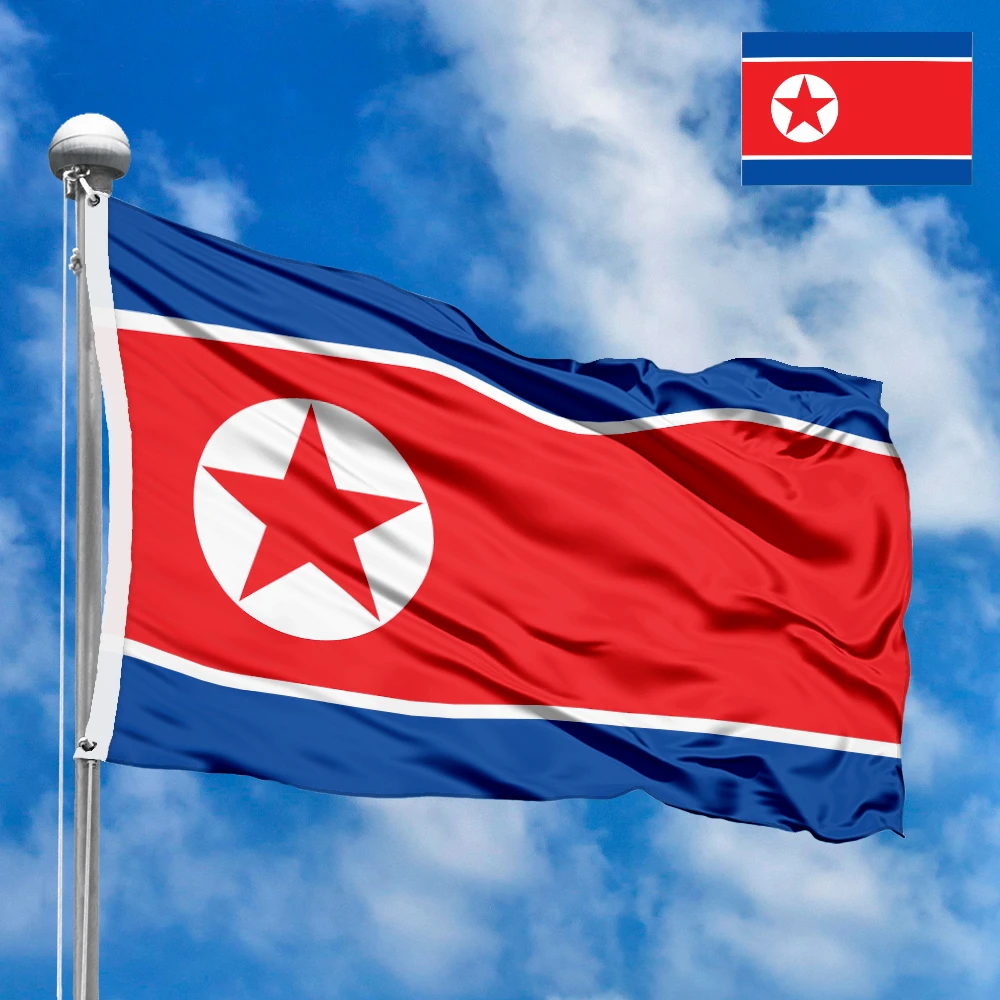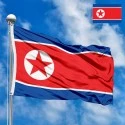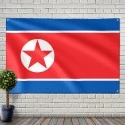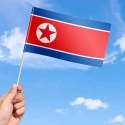The national flag of the Democratic People's Republic of Korea (DPRK), commonly known as North Korea, is a highly symbolic emblem that reflects the nation's political ideology, historical trajectory, and its guiding principles. Adopted in the tumultuous aftermath of World War II and the Korean War, the flag is a potent representation of Juche, the self-reliance ideology, and the Workers' Party of Korea's leadership. It encapsulates the aspirations for socialism, unity, and an independent path, as envisioned by its founders.
Design and Dimensions
The flag of North Korea is a distinctive design featuring a large red central panel flanked by narrow white stripes, which are in turn bordered by wider blue stripes at the top and bottom. Placed within the red central panel, near the hoist (left side), is a red five-pointed star encased within a white circle. The official proportions of the DPRK flag are typically 1:2 (height to width), giving it an elongated appearance. This specific arrangement of colors and symbols is meticulously chosen to convey specific political and national messages.
Symbolism of the Colors and Elements
Each component of the North Korean flag is imbued with specific ideological and nationalistic meanings, closely tied to the ruling Workers' Party of Korea and the Juche ideology:
-
Red Central Panel: The dominant red central panel symbolizes the revolutionary spirit and the patriotism of the Korean people. It represents the blood shed by the anti-Japanese revolutionary fighters and the struggle for the country's liberation and socialist construction. Red is also a traditional color of communism and socialism, signifying the workers' movement and the revolutionary zeal of the working class.
-
White Stripes: The narrow white stripes on either side of the red panel symbolize the purity and honesty of the Korean nation. White is a traditional color of Korea, often associated with the nation's "white-clad people" (referring to the traditional white clothing worn by Koreans) and signifying the pure, homogeneous nature of the Korean race. It also represents the unitary and peaceful character of the Korean people.
-
Blue Stripes (Top and Bottom): The wider blue stripes at the top and bottom of the flag symbolize the sovereignty, peace, and friendship with progressive peoples around the world. Blue represents the desire of the DPRK to strive for world peace and independence, and its commitment to anti-imperialist solidarity. It signifies the aspiration for a peaceful coexistence while maintaining national dignity.
-
Red Five-pointed Star: The red five-pointed star within the white circle is the primary symbol of the Workers' Party of Korea (WPK). It represents the revolutionary traditions and the leadership of the WPK in guiding the Korean revolution. The five points traditionally symbolize the five continents, signifying solidarity with revolutionaries worldwide, or the five fingers of a hand, representing unity. In the DPRK context, it firmly points to the revolutionary cause of the Workers' Party and the aspirations for communism.
-
White Circle: The white circle enclosing the star symbolizes the perfection, purity, and bright future of the Korean people under the guidance of the Workers' Party. It can also be interpreted as representing the Yin-Yang symbol from traditional Korean culture, embodying harmony, or simply the moon, a traditional East Asian symbol of unity and destiny.
History of Creation and Adoption
The current flag of North Korea was adopted shortly after the establishment of the Democratic People's Republic of Korea. Before its formal adoption, the northern part of Korea, under Soviet influence, used various flags, including those featuring the Taeguk (Yin-Yang) symbol similar to the South Korean flag, but also incorporating communist symbols.
The design of the current flag was officially unveiled and adopted on September 8, 1948, just one day after the formal establishment of the DPRK on September 9, 1948. This timing underscored its role as a foundational symbol of the new communist state, a clear break from the symbolism of the traditional Korean flag that would later be adopted by South Korea.
The flag was designed to reflect the Juche ideology of self-reliance, the leadership of the Workers' Party, and the socialist aspirations of the new state. It was a conscious effort to create a distinct national identity separate from the South and from previous historical symbols that might be associated with feudalism or colonial rule. The red star and the specific arrangement of stripes were intended to visually align the DPRK with other socialist nations while maintaining a unique Korean character through the white element.
Significance for the Inhabitants
For the people of North Korea, the national flag is an omnipresent and deeply revered symbol of the Workers' Party's leadership, national independence, and the Juche ideology. It is not merely a national emblem but a powerful visual representation of the state's very essence and its guiding philosophy. Displayed prominently in all public spaces, on buildings, in propaganda, and during mass rallies, the flag reinforces the collective identity and loyalty to the state.
It embodies the sacrifices made for the nation's liberation and the ongoing struggle for socialist construction. Citizens are educated from an early age about the flag's symbolism, fostering a profound sense of patriotism and dedication to the Party and the Supreme Leader. The flag serves as a constant reminder of the DPRK's unique political system and its self-proclaimed position as a defender of socialist values against perceived external threats. Its presence evokes a sense of unity, discipline, and unwavering commitment to the state's goals.
Interesting Facts
-
Distinct from Traditional Korean Flags: Unlike South Korea's flag (Taegukgi), which retains traditional Korean symbolism, the DPRK flag was designed to be a modern, ideologically driven emblem, breaking from historical monarchical and feudal symbols.
-
Designed by the Regime: The flag was purposefully designed by the nascent DPRK regime to articulate its new political and social order, rather than evolving from long-standing national symbols.
-
No Hammer and Sickle: While heavily influenced by communist vexillology, the DPRK flag notably does not feature the traditional hammer and sickle symbol, instead using the red star to represent the Workers' Party. This subtle difference distinguishes it from the flags of the Soviet Union or China.
-
Ubiquitous Presence: The flag is omnipresent throughout North Korea, far more so than in many other countries, reflecting its central role in state propaganda and national identity.
-
Symbol of Juche: The flag is considered a visual representation of the Juche ideology, emphasizing self-reliance, national dignity, and the Korean people's ability to forge their own destiny.
-
Strong International Message: The blue stripes, representing peace and friendship, are a key part of the DPRK's stated international aspirations, despite its often-isolated stance.
In the demonstration images, full-size flags are shown with proportions of 2:3, and hand-held flags with proportions of 1:2.






 Waving flag
Waving flag
 Sizes:
Sizes:
 Round flag
Round flag
 Sizes:
Sizes:
 Rectangular flag 2:3
Rectangular flag 2:3
 Sizes:
Sizes: